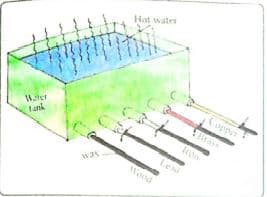Thermal Conductivity Unit UTME

Thermal conductivity is the ability of a metal to conduct heat. Though most metals are good conductors, their thermal conductivities differ from metal to metal. It is generally denoted by the symbol ‘k’ but can also be denoted by ‘λ’ and ‘κ’.
The thermal conductivity of a material is described by the following formula:
K = (QL)/(AΔT)
Where,
K is the thermal conductivity in Wm-1k-1
Q is the amount of heat transferred through the material in Joules/second or Watts
L is the distance between the two isothermal planes
A is the area of the surface in square meters
ΔT is the difference in temperature in Kelvin
Derivation
From K = (QL)/(AΔT)
The unit of Q is Joules/second or Watts i.e. the unit of power
The unit of L is meter (m)
A which is the area has unit of m2
ΔT has S.I unit of Kelvin
Then substituting all these into the above expression
K = Watt * m/m2K
K = Wm-1k-1
Therefore, the S.I unit of thermal conductivity is watt per meter per kelvin (Wm-1k-1). This can also mean Joule per second per meter per kelvin (Js-1m-1k-1)
